
Early May, we struggled to leave the house before later afternoon. Thus we did not get further than the canal.
At the start of the week, Phil cast about for an excuse to go out. With no shop requirements, he suggested going to look for goslings, snapped by a fellow photographer on the marina. Hoping they’d still be there we set off late Wednesday afternoon. We waited for a neighbour coming up the steps. “It’s so strange walking round (town) now, she remarked, “but I quite like it. Apart from missing the charity shops. I’ve got no summer clothes.” I sympathised as I also missed them. As she reached the top step, a slipper-wearing man with a mini dog rudely overtook us. The usual hippies milled about on the main road.
 We paused at the chapel where cultivated purple aquilegia competed for space with yellow wild poppies and dandelions in the untended garden. At the marina, we spotted geese, pigeons, a wagtail, a pile of pallets and a small family squatting on the cobbles, but no goslings. Walking back to the park entrance, a man sat on the cinema steps. Still talking into his phone, he abruptly stood and strode in our direction necessitating a sudden dodge.
We paused at the chapel where cultivated purple aquilegia competed for space with yellow wild poppies and dandelions in the untended garden. At the marina, we spotted geese, pigeons, a wagtail, a pile of pallets and a small family squatting on the cobbles, but no goslings. Walking back to the park entrance, a man sat on the cinema steps. Still talking into his phone, he abruptly stood and strode in our direction necessitating a sudden dodge.
In the memorial gardens, displaced pub-goers socialised on benches while in the park, children weaved about on bikes. The ‘wild flower’ patch was a riot of dandelions. On the less-trod playing field, they sprouted alongside daisies, heedless of dogs chasing balls.
 Exiting onto the towpath, signs redolent of Royston Vasey proclaimed ‘local use only’. Fish swam beneath bright ripples in the canal, but still no sign of goslings. Turning towards Mayroyd, we climbed onto the lock, avoiding another small family. A layer of scum and fallen blossom coated the water, blocking any view of wild life. The way ahead seemed rather busy. We retreated and stayed on the left side hoping to avoid busier stretches, taking the steps up to Palace House Road. Peeking over the wall down onto the canal at Hebble End, there were still no pesky goslings!
Exiting onto the towpath, signs redolent of Royston Vasey proclaimed ‘local use only’. Fish swam beneath bright ripples in the canal, but still no sign of goslings. Turning towards Mayroyd, we climbed onto the lock, avoiding another small family. A layer of scum and fallen blossom coated the water, blocking any view of wild life. The way ahead seemed rather busy. We retreated and stayed on the left side hoping to avoid busier stretches, taking the steps up to Palace House Road. Peeking over the wall down onto the canal at Hebble End, there were still no pesky goslings!
Friday (VE Day), jolly laughter, bursts of terrible music and milling about implied people on the street below were actually having a party. On our street, neighbours of the adjacent terrace socialised in their own self-created ‘bubble’. Mr. Fast n Furious raced up and parked in the middle of the thoroughfare for no apparent reason, stood there a few minutes with engine idling, then reversed out with equal speed.
 We gave all a wide berth and walked through clouds of floating dandelion seeds and upon the fading chalk art, to the end of the street, giggling at pathetic bunting in ‘Brexit Close’. We took The Buttress down to the Packhorse Bridge, and into the square where a solitary figured occupied a bench. I discovered later that an anti-lockdown demo, consisting of 8 sociopathic hippies had taken place. Getting a few errands, we popped in the fancy wine shop to smirk at the exorbitant prices and dance to Sister Sledge and purchased the fabled goat meat from the very local butchers.
We gave all a wide berth and walked through clouds of floating dandelion seeds and upon the fading chalk art, to the end of the street, giggling at pathetic bunting in ‘Brexit Close’. We took The Buttress down to the Packhorse Bridge, and into the square where a solitary figured occupied a bench. I discovered later that an anti-lockdown demo, consisting of 8 sociopathic hippies had taken place. Getting a few errands, we popped in the fancy wine shop to smirk at the exorbitant prices and dance to Sister Sledge and purchased the fabled goat meat from the very local butchers.
We wandered towards Holme Street where more half-hearted bunting adorned the school. The smoky wood smell of the people’s pizza van was a big draw, but competed with the stink of draw towards the aqueduct.
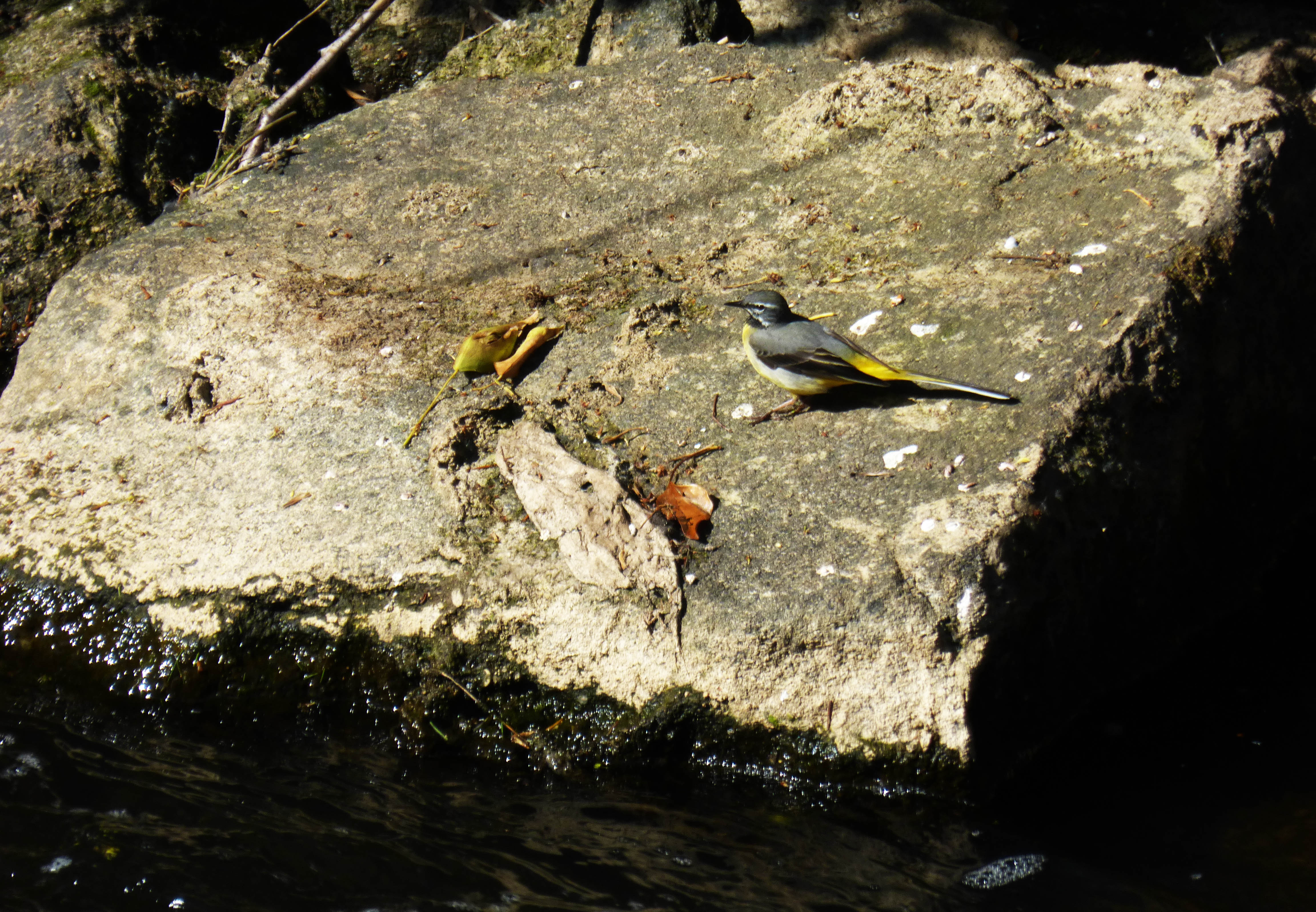 We crossed to the other side of the lock again, evading the idiotic bank holiday smokers and drinkers, and enjoying a quiet patch of sunlight until the coast cleared. Continuing past Hebble End, the angry white geese noisily defended their territory against half-breed ducks. One, a mix of mallard and runner duck, swam in an ungainly fashion, struggling to keep its long neck up . At the next exit point, we walked down a dirt track housing half-demolished vans, to the river and spotted a wagtail hopping from rock to rock.
We crossed to the other side of the lock again, evading the idiotic bank holiday smokers and drinkers, and enjoying a quiet patch of sunlight until the coast cleared. Continuing past Hebble End, the angry white geese noisily defended their territory against half-breed ducks. One, a mix of mallard and runner duck, swam in an ungainly fashion, struggling to keep its long neck up . At the next exit point, we walked down a dirt track housing half-demolished vans, to the river and spotted a wagtail hopping from rock to rock.
Around the corner, we hailed a couple of friends in their garden, chatting safely from the other side of the wall. He had been furloughed and she’d sensibly given up work as a self-employed painter for the duration, enjoying the rest. That made at least two other people liking the slower pace of life! By coincidence, she had painted the red windows reflected in the canal waters that I had shot a couple of days before (and subject of the next Monday Morning Haiga).

On Spring Bank holiday Monday, we set off slightly earlier hoping to find lunch in town. Heaving with day-trippers, carparks and bins overflowed, people queued for café take-a-ways, and benches outside the pub were fully occupied (although still not offering take-outs themselves). It appeared as if the square had become a makeshift food court. In search of pies, we found the bakers shut. The local convenience stores supplied meagre pickings. We waited ages while a family who looked like they’d already eaten all the pies, hovered round the instant food section. The staff complained about the tourists “There are at least 300 people in the square”, one of them exaggerated. Navigating the busy street, almost mowed down by a motorbike, we crossed over to the park to find a suitable patch of grass amidst the small groups populating the green spaces, in front of the shut café. I said they could at least be selling ice cream.
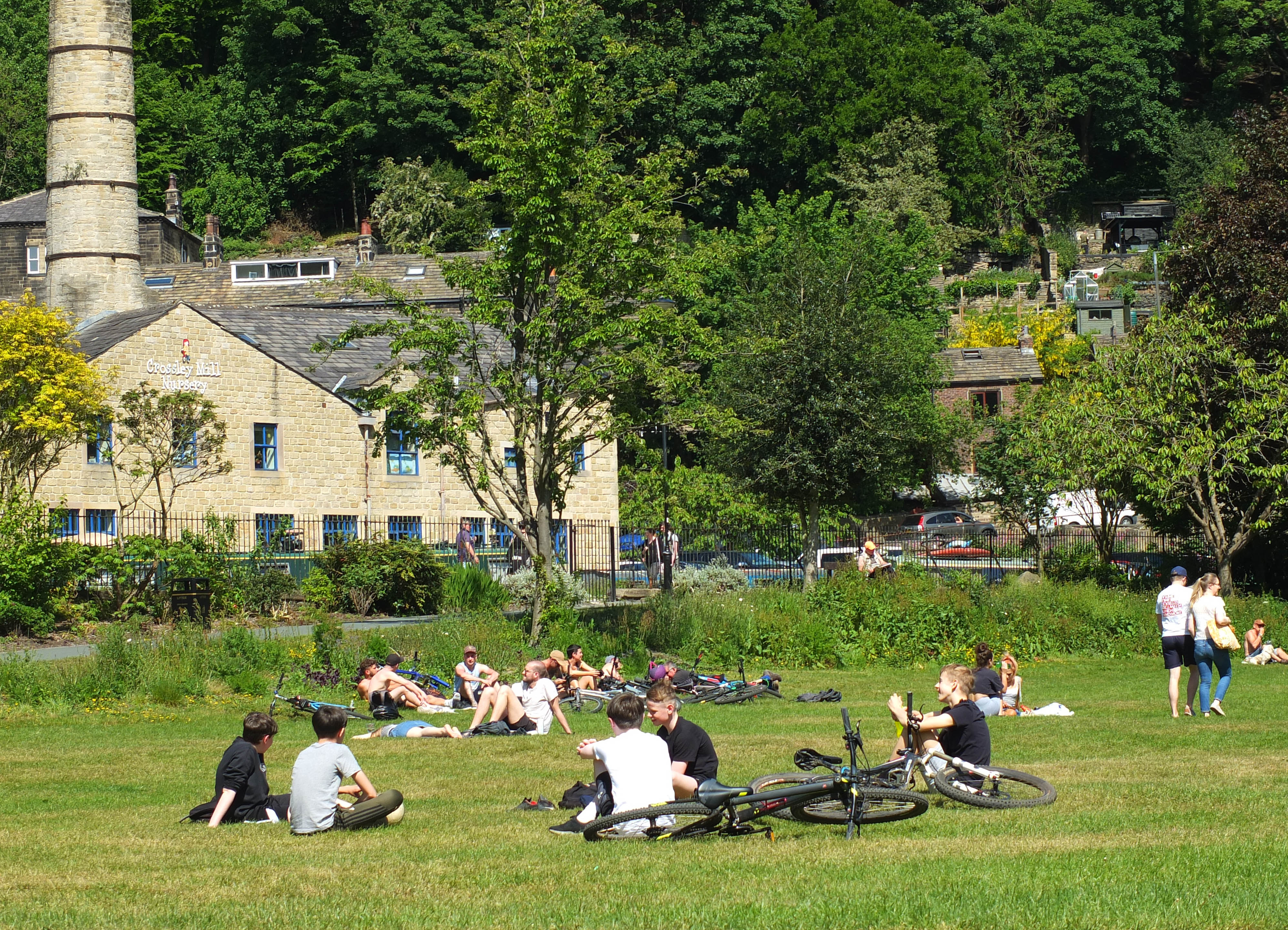 We enjoyed a long overdue picnic lunch in the warm sunshine, realising it was the first time since early March we had bought ‘lunch out’. Discussing the recent Cummings farrago, we agreed the cat was out of the bag now. Although physical distancing was not being totally ignored, friendship groups had definitely formed. I learnt the art beloved of Daily Mail photographers, misleading the viewer into thinking small clumps of people were actually one seething mass. An infamous local character staggered from one group to another, wearing a mask round his chin. Phil suggested his keyworker probably put a stack in his house to protect the rest of us!
We enjoyed a long overdue picnic lunch in the warm sunshine, realising it was the first time since early March we had bought ‘lunch out’. Discussing the recent Cummings farrago, we agreed the cat was out of the bag now. Although physical distancing was not being totally ignored, friendship groups had definitely formed. I learnt the art beloved of Daily Mail photographers, misleading the viewer into thinking small clumps of people were actually one seething mass. An infamous local character staggered from one group to another, wearing a mask round his chin. Phil suggested his keyworker probably put a stack in his house to protect the rest of us!
After eating, we walked along the canal to Mytholmroyd. Delicate white flowers and common orchids resembling bottle brushes swayed gently at the water’s edge, dwarfed by Margarites.
 At the boundary, more Margarites grew in hard gravel also home to a smattering of clover and trefoil. We crossed the main road to the ancient hamlet of Hawksclough and walked home via the Sustrans cycle path. As the habitat changed, so did the flora. Bright kingcups dazzled beside grey granite while fading wild garlic and miniscule blooms stretched upwards in the shade of riverside trees.
At the boundary, more Margarites grew in hard gravel also home to a smattering of clover and trefoil. We crossed the main road to the ancient hamlet of Hawksclough and walked home via the Sustrans cycle path. As the habitat changed, so did the flora. Bright kingcups dazzled beside grey granite while fading wild garlic and miniscule blooms stretched upwards in the shade of riverside trees.
I popped in the co-op while Phil waited outside. The halfwit serving me spoke into his headset: “we appear to have a stalker at the window.“ I turned round to see Phil doing funny faces behind my back!













 We paused at the chapel where cultivated purple aquilegia competed for space with yellow wild poppies and dandelions in the untended garden. At the marina, we spotted geese, pigeons, a wagtail, a pile of pallets and a small family squatting on the cobbles, but no goslings. Walking back to the park entrance, a man sat on the cinema steps. Still talking into his phone, he abruptly stood and strode in our direction necessitating a sudden dodge.
We paused at the chapel where cultivated purple aquilegia competed for space with yellow wild poppies and dandelions in the untended garden. At the marina, we spotted geese, pigeons, a wagtail, a pile of pallets and a small family squatting on the cobbles, but no goslings. Walking back to the park entrance, a man sat on the cinema steps. Still talking into his phone, he abruptly stood and strode in our direction necessitating a sudden dodge. Exiting onto the towpath, signs redolent of Royston Vasey proclaimed ‘local use only’. Fish swam beneath bright ripples in the canal, but still no sign of goslings. Turning towards Mayroyd, we climbed onto the lock, avoiding another small family. A layer of scum and fallen blossom coated the water, blocking any view of wild life. The way ahead seemed rather busy. We retreated and stayed on the left side hoping to avoid busier stretches, taking the steps up to Palace House Road. Peeking over the wall down onto the canal at Hebble End, there were still no pesky goslings!
Exiting onto the towpath, signs redolent of Royston Vasey proclaimed ‘local use only’. Fish swam beneath bright ripples in the canal, but still no sign of goslings. Turning towards Mayroyd, we climbed onto the lock, avoiding another small family. A layer of scum and fallen blossom coated the water, blocking any view of wild life. The way ahead seemed rather busy. We retreated and stayed on the left side hoping to avoid busier stretches, taking the steps up to Palace House Road. Peeking over the wall down onto the canal at Hebble End, there were still no pesky goslings! We gave all a wide berth and walked through clouds of floating dandelion seeds and upon the fading chalk art, to the end of the street, giggling at pathetic bunting in ‘Brexit Close’. We took The Buttress down to the Packhorse Bridge, and into the square where a solitary figured occupied a bench. I discovered later that an anti-lockdown demo, consisting of 8 sociopathic hippies had taken place. Getting a few errands, we popped in the fancy wine shop to smirk at the exorbitant prices and dance to Sister Sledge and purchased the fabled goat meat from the very local butchers.
We gave all a wide berth and walked through clouds of floating dandelion seeds and upon the fading chalk art, to the end of the street, giggling at pathetic bunting in ‘Brexit Close’. We took The Buttress down to the Packhorse Bridge, and into the square where a solitary figured occupied a bench. I discovered later that an anti-lockdown demo, consisting of 8 sociopathic hippies had taken place. Getting a few errands, we popped in the fancy wine shop to smirk at the exorbitant prices and dance to Sister Sledge and purchased the fabled goat meat from the very local butchers. We crossed to the other side of the lock again, evading the idiotic bank holiday smokers and drinkers, and enjoying a quiet patch of sunlight until the coast cleared. Continuing past Hebble End, the angry white geese noisily defended their territory against half-breed ducks. One, a mix of mallard and runner duck, swam in an ungainly fashion, struggling to keep its long neck up . At the next exit point, we walked down a dirt track housing half-demolished vans, to the river and spotted a wagtail hopping from rock to rock.
We crossed to the other side of the lock again, evading the idiotic bank holiday smokers and drinkers, and enjoying a quiet patch of sunlight until the coast cleared. Continuing past Hebble End, the angry white geese noisily defended their territory against half-breed ducks. One, a mix of mallard and runner duck, swam in an ungainly fashion, struggling to keep its long neck up . At the next exit point, we walked down a dirt track housing half-demolished vans, to the river and spotted a wagtail hopping from rock to rock.
 We enjoyed a long overdue picnic lunch in the warm sunshine, realising it was the first time since early March we had bought ‘lunch out’. Discussing the recent Cummings farrago, we agreed the cat was out of the bag now. Although physical distancing was not being totally ignored, friendship groups had definitely formed. I learnt the art beloved of Daily Mail photographers, misleading the viewer into thinking small clumps of people were actually one seething mass. An infamous local character staggered from one group to another, wearing a mask round his chin. Phil suggested his keyworker probably put a stack in his house to protect the rest of us!
We enjoyed a long overdue picnic lunch in the warm sunshine, realising it was the first time since early March we had bought ‘lunch out’. Discussing the recent Cummings farrago, we agreed the cat was out of the bag now. Although physical distancing was not being totally ignored, friendship groups had definitely formed. I learnt the art beloved of Daily Mail photographers, misleading the viewer into thinking small clumps of people were actually one seething mass. An infamous local character staggered from one group to another, wearing a mask round his chin. Phil suggested his keyworker probably put a stack in his house to protect the rest of us! At the boundary, more Margarites grew in hard gravel also home to a smattering of clover and trefoil. We crossed the main road to the ancient hamlet of Hawksclough and walked home via the Sustrans cycle path. As the habitat changed, so did the flora. Bright kingcups dazzled beside grey granite while fading wild garlic and miniscule blooms stretched upwards in the shade of riverside trees.
At the boundary, more Margarites grew in hard gravel also home to a smattering of clover and trefoil. We crossed the main road to the ancient hamlet of Hawksclough and walked home via the Sustrans cycle path. As the habitat changed, so did the flora. Bright kingcups dazzled beside grey granite while fading wild garlic and miniscule blooms stretched upwards in the shade of riverside trees.
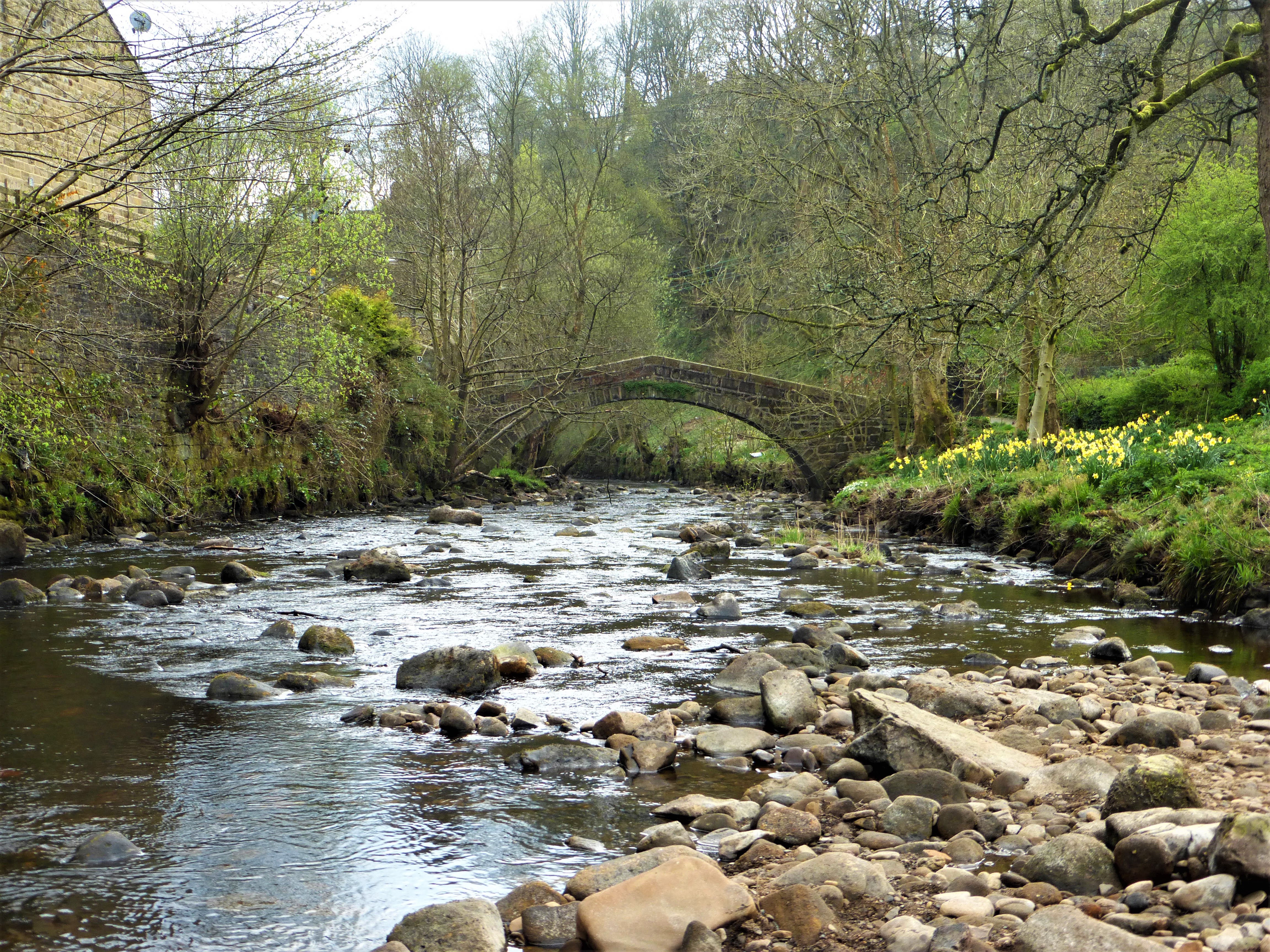
 On Oldgate, Canada Geese sat unflustered by the river. On Hangingroyd Road a mother and child cycled round an empty carpark fringed with white and orange tree blossom. Continuing to Victoria Road, rainbows decorated windows and chalk Easter eggs adorned pavements. People chatted, straddling the road as a mad cat lady took her cats for a jog.
On Oldgate, Canada Geese sat unflustered by the river. On Hangingroyd Road a mother and child cycled round an empty carpark fringed with white and orange tree blossom. Continuing to Victoria Road, rainbows decorated windows and chalk Easter eggs adorned pavements. People chatted, straddling the road as a mad cat lady took her cats for a jog. From Foster Mill Bridge, we saw several people occupying the riverside path. A woman with a dog came towards us necessitating a hasty move. The grassy riverbank was resplendent with daffodils. Horse chestnuts started to sprout, heedless of parasitic moss hijacking their drier branches. Hebden Water resembled silvery ribbons flowing downstream.
From Foster Mill Bridge, we saw several people occupying the riverside path. A woman with a dog came towards us necessitating a hasty move. The grassy riverbank was resplendent with daffodils. Horse chestnuts started to sprout, heedless of parasitic moss hijacking their drier branches. Hebden Water resembled silvery ribbons flowing downstream.
 Gasping for air amidst the spring foliage, flowers shone in the brilliant sunlight, including impossibly yellow celandine and soft-toned early bluebells. We jumped over the wall to the top of the swamp. Our shadows lay atop the stagnant water of the old mill ponds and glinting fish swam just below the surface.
Gasping for air amidst the spring foliage, flowers shone in the brilliant sunlight, including impossibly yellow celandine and soft-toned early bluebells. We jumped over the wall to the top of the swamp. Our shadows lay atop the stagnant water of the old mill ponds and glinting fish swam just below the surface.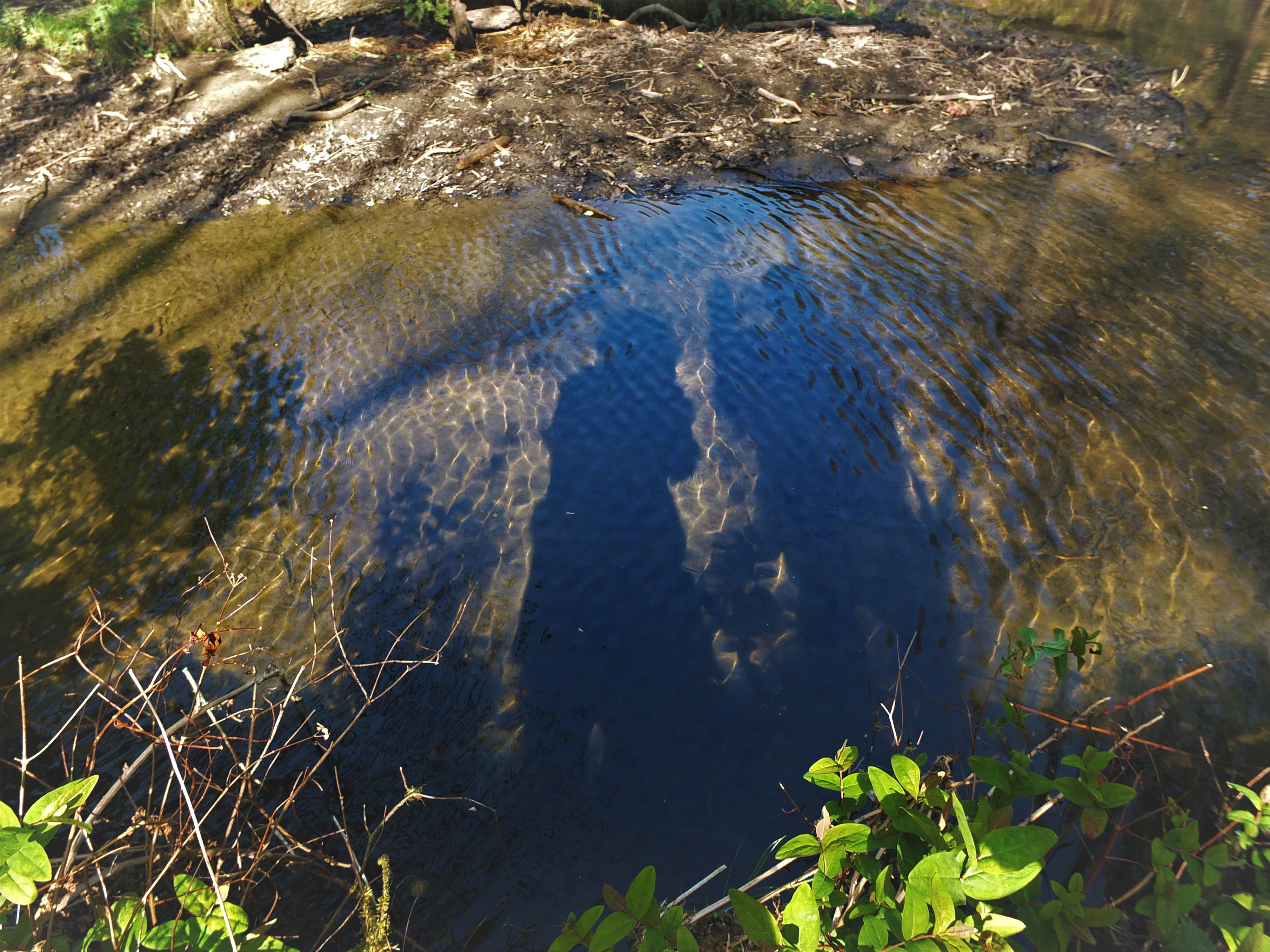


 Moss continued its relentless quest to obliterate the graffiti, with artistic effect. Just before the site of the old Walkleys Mill (Still odd to see flattened), we turned sharp right up to the green railway bridge and followed the path skirting the bottom of Crow Nest wood.
Moss continued its relentless quest to obliterate the graffiti, with artistic effect. Just before the site of the old Walkleys Mill (Still odd to see flattened), we turned sharp right up to the green railway bridge and followed the path skirting the bottom of Crow Nest wood.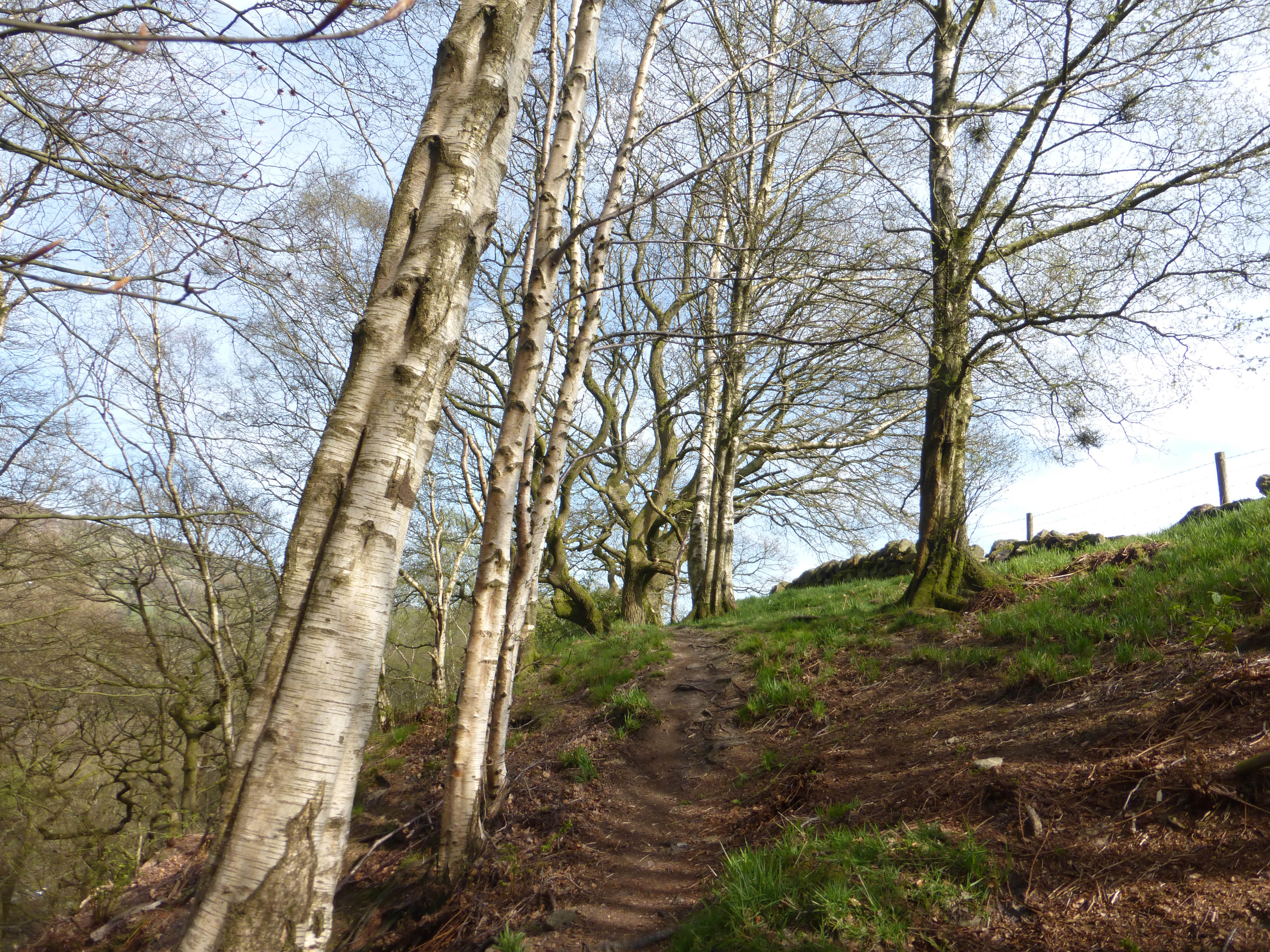
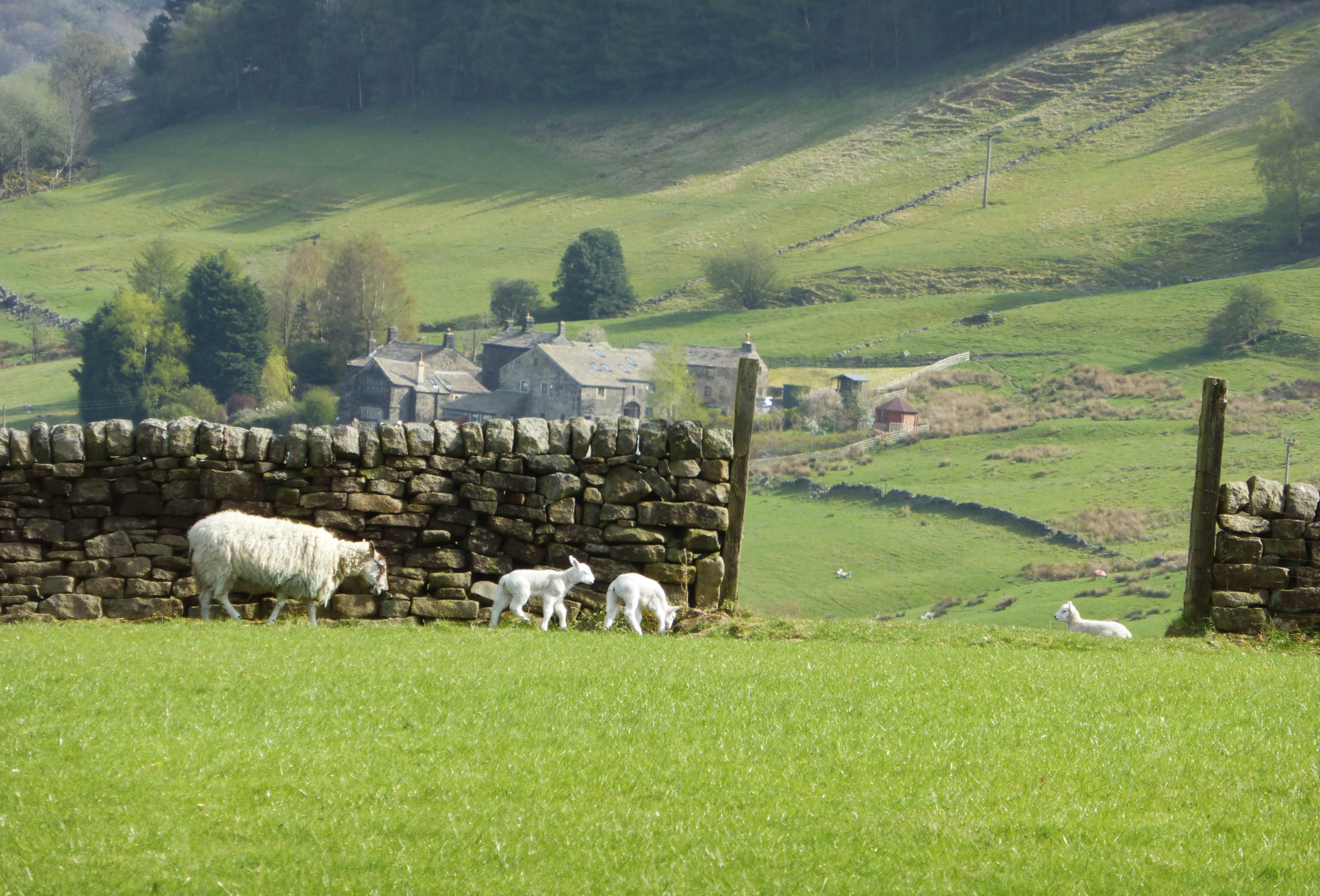 At the top, sheep with lambs so brand new they shone white, grazed in a meadow, fenced with barbed wire. Further on, last year’s beech nut husks clung onto spindly twigs. Bluebells had started to emerge while the brook had almost totally dried up. From the top we could see the quarry was equally arid. From the top we could see the quarry was equally arid. A pair of women waited for us and I thanked them heartily; it made a change for us not to be the ones who paused.
At the top, sheep with lambs so brand new they shone white, grazed in a meadow, fenced with barbed wire. Further on, last year’s beech nut husks clung onto spindly twigs. Bluebells had started to emerge while the brook had almost totally dried up. From the top we could see the quarry was equally arid. From the top we could see the quarry was equally arid. A pair of women waited for us and I thanked them heartily; it made a change for us not to be the ones who paused. On Wood Top Road, we again had to stand on the verge a couple of times for other walkers, using the opportunity to take pleasure in a squirrel jumping between high branches and resplendent native white cherry blossom.
On Wood Top Road, we again had to stand on the verge a couple of times for other walkers, using the opportunity to take pleasure in a squirrel jumping between high branches and resplendent native white cherry blossom.

 Sowerby Street led uphill. An incongruent concrete block was fronted by a small parade of shops, most seemingly shut. Upper floors housed maisonettes. Ahead of us, a faded sign on the side of The Royal Oak made us wonder if the pub still served Whitaker’s ales and stout.
Sowerby Street led uphill. An incongruent concrete block was fronted by a small parade of shops, most seemingly shut. Upper floors housed maisonettes. Ahead of us, a faded sign on the side of The Royal Oak made us wonder if the pub still served Whitaker’s ales and stout. A bend eventually marked the start of Sowerby Village with the Church Stile Inn the first sign we had reached our destination. The imposingly dark church stood proudly on the opposite corner. A side gate led into the graveyard. Going round to the unlocked front door, we entered to find St. Peter’s looking quite busy but soon surmised the occupants were all church people, with us the sole visitors who’d come on spec. Undaunted, we explored the interior. Sunbeams shone through amazing stained-glass windows. Ornate plasterwork decorated the wall above the altar. An intriguing balcony was unfortunately out of bounds. Display boards showed stills of film scenes from the BBC drama Gentleman Jack – the church had stood in for St. Martin’s in the Field.
A bend eventually marked the start of Sowerby Village with the Church Stile Inn the first sign we had reached our destination. The imposingly dark church stood proudly on the opposite corner. A side gate led into the graveyard. Going round to the unlocked front door, we entered to find St. Peter’s looking quite busy but soon surmised the occupants were all church people, with us the sole visitors who’d come on spec. Undaunted, we explored the interior. Sunbeams shone through amazing stained-glass windows. Ornate plasterwork decorated the wall above the altar. An intriguing balcony was unfortunately out of bounds. Display boards showed stills of film scenes from the BBC drama Gentleman Jack – the church had stood in for St. Martin’s in the Field. We explored the immediate vicinity of St. Peter’s Square where the primary school had been turned into a church hall. Phil checked google for a different way to Sowerby Bridge. As I expected, there was none. We returned the way we’d come. Obviously quicker downhill, we occasionally stopped to admire valley views, picking out landmarks and peculiarities. Lone cats stalked about in long grass. Tall towers loomed in the distance. A line of toy cars had been parked neatly beneath a garden swing. Upper Gaukroger sounded unusual; the name turned out to be idiosyncratically Yorkshirei i.
We explored the immediate vicinity of St. Peter’s Square where the primary school had been turned into a church hall. Phil checked google for a different way to Sowerby Bridge. As I expected, there was none. We returned the way we’d come. Obviously quicker downhill, we occasionally stopped to admire valley views, picking out landmarks and peculiarities. Lone cats stalked about in long grass. Tall towers loomed in the distance. A line of toy cars had been parked neatly beneath a garden swing. Upper Gaukroger sounded unusual; the name turned out to be idiosyncratically Yorkshirei i. Towards the town centre, a makeshift campsite had been constructed near the weir. We wondered at the ostentatious architecture, particularly the odd shape of the town hall and the fake art deco defunct cinema. We ducked into a wharfside pub to use facilities but were not tempted to stay. Narrow alleys provided a shortcut to the station. In the subway again, Phil this time noticed the stink and surmised there must be a station cat.
Towards the town centre, a makeshift campsite had been constructed near the weir. We wondered at the ostentatious architecture, particularly the odd shape of the town hall and the fake art deco defunct cinema. We ducked into a wharfside pub to use facilities but were not tempted to stay. Narrow alleys provided a shortcut to the station. In the subway again, Phil this time noticed the stink and surmised there must be a station cat.

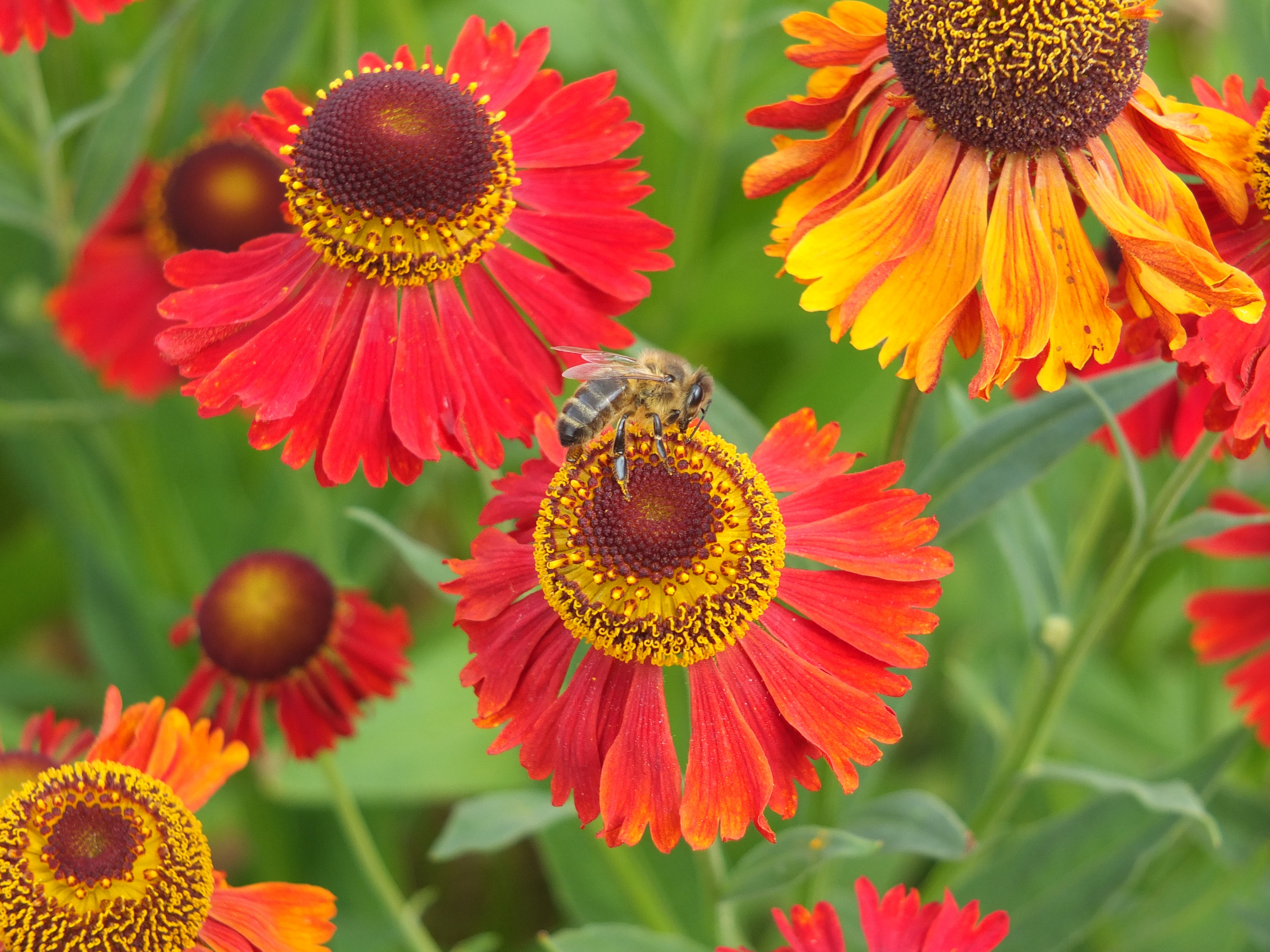
 The second turning on the left marked the start of our climb up Cross Stone Road. Urban landscapes quickly gave way to a more rural aspect. Steep curves led us past dark green verges, almost submerging large stones and unkempt benches. An old toll house had been converted into a twee cottage.
The second turning on the left marked the start of our climb up Cross Stone Road. Urban landscapes quickly gave way to a more rural aspect. Steep curves led us past dark green verges, almost submerging large stones and unkempt benches. An old toll house had been converted into a twee cottage. On a further ridge, we tried to differentiate between ancient markings and modern bunkers. A second golfer shouted sarcastically “take your time!” before informing us about a public footpath along the top edge of the green. This turned out to be quite pleasant. Edged with small shrubs, grasses and willow herbs, we discovered what looked like a grave marked by a standing stone in a boggy patch.
On a further ridge, we tried to differentiate between ancient markings and modern bunkers. A second golfer shouted sarcastically “take your time!” before informing us about a public footpath along the top edge of the green. This turned out to be quite pleasant. Edged with small shrubs, grasses and willow herbs, we discovered what looked like a grave marked by a standing stone in a boggy patch. Quest over, we returned to the marked path. A gap in a lovely stone wall led back onto the lane. I developed indigestion as a result of eating just before embarking on the climb. I tried to ignore it and concentrated on the pleasant walk down. In places, hedgerows of hawthorns were fronted by stone walls suggesting that Medieval hedges had then been added to later.
Quest over, we returned to the marked path. A gap in a lovely stone wall led back onto the lane. I developed indigestion as a result of eating just before embarking on the climb. I tried to ignore it and concentrated on the pleasant walk down. In places, hedgerows of hawthorns were fronted by stone walls suggesting that Medieval hedges had then been added to later. The extremely narrow path soon arrived at some steps. A woman gardening informed us of the way to go, but it seemed to be leading in the wrong direction. The untrodden path took on a spooky aspect, until we reached another ‘junction’.
The extremely narrow path soon arrived at some steps. A woman gardening informed us of the way to go, but it seemed to be leading in the wrong direction. The untrodden path took on a spooky aspect, until we reached another ‘junction’.

 Alighting in the village, Phil stood in a patch of sun and declared he was stopping there. I laughed. We walked up Towngate and turned right.
Alighting in the village, Phil stood in a patch of sun and declared he was stopping there. I laughed. We walked up Towngate and turned right.
 I had expected to go more or less straight down to Midgehole but hadn’t factored in the steep cliff-like drop, hence the path travelled westwards as it descended, until it met with the bottom of Northwell Lane.
I had expected to go more or less straight down to Midgehole but hadn’t factored in the steep cliff-like drop, hence the path travelled westwards as it descended, until it met with the bottom of Northwell Lane.



 Coming back, we noticed a few bluebells in flower as we climbed up to the top causeway, enjoying being level with the tree tops.
Coming back, we noticed a few bluebells in flower as we climbed up to the top causeway, enjoying being level with the tree tops.